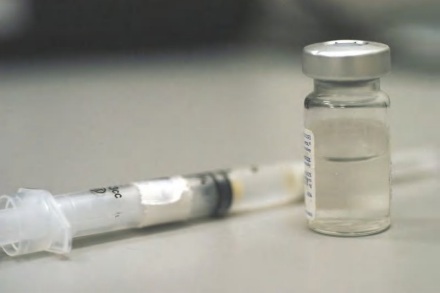Vaccines: Friend or Foe?
Immunization questions answered on the 'Line.
Melinda Wenner • September 1, 2006

To prick or not to prick?
So, did the thimerosal present in vaccines before 1999 cause autism in some of the exposed children?
When the American Academy of Pediatrics and the United States Public Health Service suggested in 1999 that thimerosal-containing vaccines be removed as soon as possible, many parents viewed this as an admission of guilt: They thought that the organizations were saying that the levels of thimerosal in vaccines were definitively dangerous.
At that point, however, no one was certain of its effects.
Some parents of autistic children jumped on the idea of thimerosal as the link between vaccines and autism, citing studies that have shown that some autistics have high mercury levels in their bodies that can only be explained by thimerosal exposure. They theorized that autistics inherit a genetic makeup that inhibits their bodies’ abilities to detoxify metals, such that thimerosal causes significant metal poisoning—and eventually neurodegenerative disorders like autism.
Laboratory studies have uncovered several potential mechanisms by which thimerosal in vaccines might cause neural problems. Richard Deth, a pharmacology professor at Northeastern University, published a study showing that thimerosal inhibits methylation, a process required for neural circuits to function properly.
Researchers at Columbia showed that thimerosal causes autism-like symptoms in mice, and third study revealed that many autistics have lower levels of glutathione, a mercury-detoxifying chemical, in their blood.
And while laboratory studies have also shown a connection between thimerosal and autism-like symptoms in mice, these studies do not prove that the doses of thimerosal in vaccines did, in fact, lead to neurodegenerative problems in children. Large epidemiological studies are far better at determining true cause-and-effect relationships, and they have revealed no link.
Five studies, including one of more than 400,000 Danish children, found no association between exposure to thimerosal-containing vaccines and autism. Based on these findings, as well as analyses of additional epidemiological and ecological studies, the IOM released a report in 2004 confirming that thimerosal in vaccines did not cause autism. “We found no evidence of toxic effects at the dosage in vaccines,” said Dr. Marie McCormack, a professor at the Harvard School of Public Health who served as chair of the IOM committee.
So while there is little doubt that thimerosal is toxic, there is no definitive epidemiological evidence that the amount present in vaccines caused harm.
“The general consensus among vaccine experts is that there is no evidence that thimerosal poses a risk in the small quantities that were present in vaccines,” wrote Sanford Kimmel, a family medicine professor the Medical University of Ohio, in an e-mail.
Why, then, have vaccines been linked multiple times to autism?
One of the reasons vaccines have been so frequently linked to autism is because no one knows what, exactly, causes the disorder. Most doctors believe that autism, which falls under the umbrella of Pervasive Developmental Disorders (PDD), has a strong genetic component but that genes alone aren’t to blame—it may not develop unless sparked by as yet unidentified environmental “triggers.”
Symptoms of autism, which include abnormal social interactions and impaired communication abilities, often surface right around the time kids receive their vaccinations—leading parents to believe that vaccines are the culprit. And autism rates are approximately 20 times higher today than they were in the 1940s. The increase roughly correlates with the spread of global immunization programs. Some doctors, however, say that apparent rises in autism rates are really the result of better diagnoses.
What is the risk of a complication occurring after vaccination? How are vaccines tested to ensure that they are safe?
According to the CDC, the risk associated with immunization is “so small that it is hard to assess statistically” and “the risk of the disease itself is substantially more serious.”
Today’s vaccines are checked at multiple points during development to ensure their safety and effectiveness. In order to get licensed, a vaccine must complete three stages of clinical trials. Then, external advisory committees discuss the data and advise the FDA whether or not it should be granted licensure. If the license is granted, the FDA requires manufacturers to submit samples of each vaccine lot along with results of potency, safety and purity tests before allowing the lot to be released to health care providers.
I’ve heard that outbreaks can occur in communities in which everyone has been immunized. How does this happen?
The truth is, no vaccine is 100 percent effective. There is a chance, albeit very small, that someone who has been immunized for a disease can later catch it anyway. In addition, some vaccines also require booster shots or multiple injections, so it’s important to ensure that your child receives all the required doses.
Additionally, if everyone in a community is vaccinated, a disease will have difficulty spreading from person to person in the unlikely (but not impossible) event of an outbreak. Vaccination is important not only for your child’s individual health, but also to maximize the entire community’s immunity to disease—so that an outbreak is unlikely to reach your child in the first place.
For more information on the recommended 2006 U.S. vaccination schedules, as well as detailed information about individual vaccines, visit the CDC’s National Immunization Program website.
1 Comment
hello dear melinda, this is good ol chad from UM composition department.
Good article!